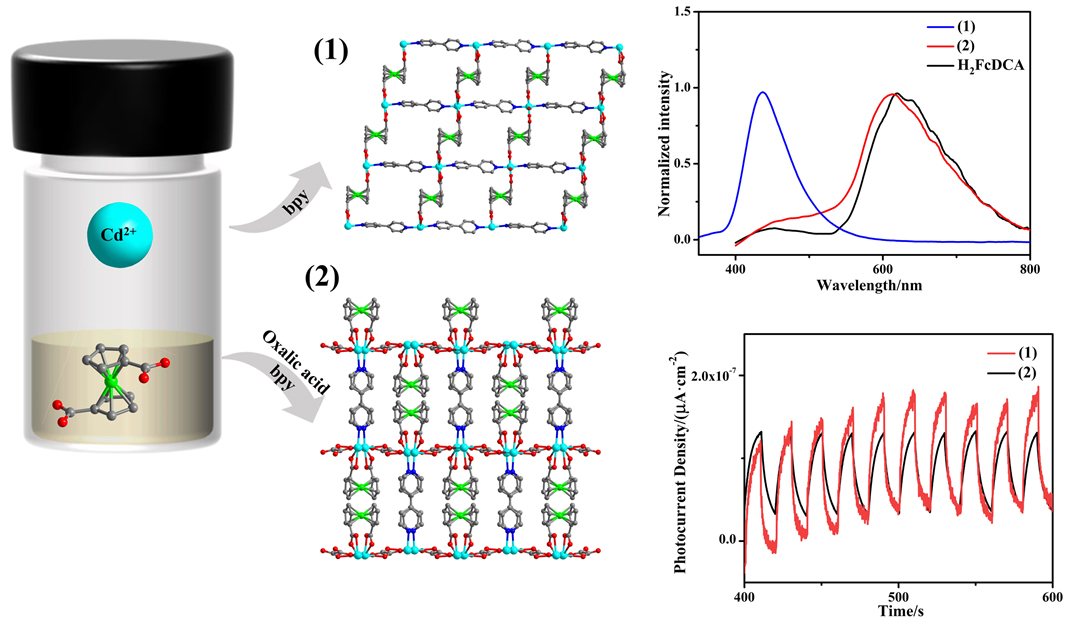| [1] |
Kealy, T. J.; Pauson, P. L. Nature 1951, 168, 1039.
|
| [2] |
Liang, Y.; Xu, X. D.; Ni, J. L.; Li, J. F.; Wang, F. M. Chin. J. Struct. Chem. 2021, 40, 193. (in Chinese)
|
|
(梁宇, 许秀典, 倪建玲, 李俊峰, 汪芳明, 结构化学, 2021, 40, 193.)
|
| [3] |
Wang, X. T.; Wei, W.; Zhang, K.; Du, S. W. Chin. J. Struct. Chem. 2021, 40, 369. (in Chinese)
|
|
(王雪婷, 魏伟, 张凯, 杜少武, 结构化学, 2021, 40, 369.)
|
| [4] |
Chen, R. Y.; Chen, G. H.; He, Y. P.; Zhang, J. Chin. J. Struct. Chem. 2022, 41, 2201001. (in Chinese)
|
|
(陈瑞燕, 陈光辉, 何燕萍, 张健, 结构化学, 2022, 41, 2201001.)
|
| [5] |
Li, G. P.; Li, Z. Z.; Xie, H. F.; Fu, Y. L.; Wang, Y. Y. Chin. J. Struct. Chem. 2021, 40, 1047. (in Chinese)
|
|
(李高鹏, 李贞贞, 谢红芳, 付云龙, 王尧宇, 结构化学, 2021, 40, 1047.)
|
| [6] |
Zhao, Y.-W.; Li, X.; Zhang, F.-Q.; Zhang, X. Acta Chim. Sinica 2021, 79, 1409. (in Chinese)
doi: 10.6023/A21100474
|
|
(赵彦武, 李星, 张富强, 张祥, 化学学报, 2021, 79, 1409.)
doi: 10.6023/A21100474
|
| [7] |
Hao, X.-K.; Zhai, Z.-Y.; Sun, Y. -X.; Li, C.-J. Acta Chim. Sinica 2022, 80, 49. (in Chinese)
doi: 10.6023/A21080402
|
|
(郝肖柯, 翟振宇, 孙亚昕, 李从举, 化学学报, 2022, 80, 49.)
doi: 10.6023/A21080402
|
| [8] |
Chen, G. H.; He, Y. P.; Zhang, L.; Zhang, J. Acta Chim. Sinica 2020, 78, 1411. (in Chinese)
doi: 10.6023/A20070337
|
|
(陈光辉, 何燕萍, 张磊, 张健, 化学学报, 2020, 78, 1411.)
doi: 10.6023/A20070337
|
| [9] |
Dong, J.-L.; Shen, L.-Z.; Wen, B.; Song, Z.; Feng, J. J.; Liang, G.; Liu, B.; Yang, B. S. Acta Chim. Sinica 2020, 78, 1260. (in Chinese)
doi: 10.6023/A20070285
|
|
(董金龙, 沈腊珍, 文斌, 宋珍, 冯俊杰, 梁钢, 刘斌, 杨斌盛, 化学学报, 2020, 78, 1260.)
doi: 10.6023/A20070285
|
| [10] |
Zhou, H. L.; Zhang, Y. B.; Zhang, J. P.; Chen, X. M. Nat. Commun. 2015, 6, 6917.
doi: 10.1038/ncomms7917
|
| [11] |
Patra, M.; Gasser, G. Nat. Rev. Chem. 2017, 1, 0066.
doi: 10.1038/s41570-017-0066
|
| [12] |
Ludwig, B. S.; Correia, J. D. G.; Kühn, F. E. Coord. Chem. Rev. 2019, 396, 22.
doi: 10.1016/j.ccr.2019.06.004
|
| [13] |
Qian, Y.; Sun, Y.-M.; Liu, J.-Z. Acta Chim. Sinica 1998, 56, 453. (in Chinese)
|
|
(钱鹰, 孙岳明, 刘举正, 化学学报, 1998, 56, 340.)
|
| [14] |
Kaur, S.; Kaur, M.; Kaur, P.; Clays, K.; Singh, K. Coord. Chem. Rev. 2017, 343, 185.
doi: 10.1016/j.ccr.2017.05.008
|
| [15] |
Gu, H. B.; Mu, S. D.; Qiu, G. R.; Liu, X.; Zhang, L.; Yuan, Y. F.; Astruc, D. Coord. Chem. Rev. 2018, 364, 51.
doi: 10.1016/j.ccr.2018.03.013
|
| [16] |
Dwadnia, N.; Roger, J.; Pirio, N.; Cattey, H.; Hierso, J. C. Coord. Chem. Rev. 2018, 355, 74.
doi: 10.1016/j.ccr.2017.07.015
|
| [17] |
Liu, J. J.; Li, N.; Sun, J. W.; Liu, J.; Dong, L. Z.; Yao, S. J.; Zhang, L.; Xin, Z. F.; Shi, J. W.; Wang, J. X.; Li, S. L.; Lan, Y. Q. ACS Catal. 2021, 11, 4510.
doi: 10.1021/acscatal.0c04495
|
| [18] |
Rajak, R.; Saraf, M.; Mohammad, A.; Mobin, S. M. J. Mater. Chem. A 2017, 5, 17998.
doi: 10.1039/C7TA03773B
|
| [19] |
Han, E. M.; Yu, W. D.; Li, L. J.; Yi, X. Y.; Yan, J.; Liu, C. Chem. Commun. 2021, 57, 2792.
doi: 10.1039/D1CC00019E
|
| [20] |
Li, G.; Hou, H. W.; Li, L. K.; Meng, X. R.; Fan, Y. T.; Zhu, Y. Inorg. Chem. 2003, 42, 4995.
doi: 10.1021/ic034324a
|
| [21] |
Meng, X. R.; Li, G.; Hou, H. W.; Han, H. Y.; Fan, Y. T.; Zhu, Y.; Du, C. X. J. Organomet. Chem. 2003, 679, 153.
doi: 10.1016/S0022-328X(03)00516-3
|
| [22] |
Deng, Z.; Fang, C.; Ma, X.; Li, X.; Zeng, Y.-J.; Peng, X. ACS Appl. Mater. Interfaces 2020, 12, 20321.
doi: 10.1021/acsami.0c06648
|
| [23] |
Hirai, K.; Uehara, H.; Kitagawa, S.; Furukawa, S. Dalton Trans. 2012, 41, 3924.
doi: 10.1039/c2dt12304e
|
| [24] |
Benecke, J.; Grape, E. S.; Fuss, A.; Wohlbrandt, S.; Engesser, T. A.; Inge, A. K.; Stock, N.; Reinsch, H. Inorg. Chem. 2020, 59, 9969.
doi: 10.1021/acs.inorgchem.0c01124
pmid: 32628458
|
| [25] |
Gao, R.; Chen, S. M.; Wang, F.; Zhang, J. Inorg. Chem. 2021, 60, 239.
doi: 10.1021/acs.inorgchem.0c02878
|
| [26] |
Du, C.-L.; Wang, L.-H.; Jiang, N.; Huang, X.-H. Acta Chim. Sinica 2011, 69, 601. (in Chinese)
|
|
(杜春蕾, 王丽红, 江娜, 黄晓华, 化学学报, 2011, 69, 601.)
|
| [27] |
Yue, Q.; Wang, Y. Y.; Hu, X. L.; Guo, X. W.; Gao, E. Q. CrystEngComm 2019, 21, 6719.
doi: 10.1039/c9ce01128e
|
| [28] |
Kim, J.; Jo, H.; Yoon, S. W.; Lee, M. H.; Choi, W. J.; Choi, K. Y.; Ok, K.M. Eur. J. Inorg. Chem. 2020, 5, 452.
|
| [29] |
Wang, X. Y.; Li, X. M.; Pan, Y. R.; Liu, B.; Zhou, S. Chin. J. Struct. Chem. 2019, 38, 1275. (in Chinese)
|
|
(王秀艳, 李秀梅, 潘亚茹, 刘博, 周实, 结构化学, 2019, 38, 1275.)
|
| [30] |
Li, Z. T.; Ding, L. W.; Wang, Y. L. Chin. J. Struct. Chem. 2020, 39, 132. (in Chinese)
|
|
(李振涛, 丁立稳, 王玉玲, 结构化学, 2020, 39, 132.)
|
| [31] |
Wang, X. W.; Chen, J. Z.; Liu, J. Naturforsch. 2007, 62, 1139.
|
 ), 王飞b,*(
), 王飞b,*( ), 张健b
), 张健b
 ), Fei Wangb(
), Fei Wangb( ), Jian Zhangb
), Jian Zhangb
